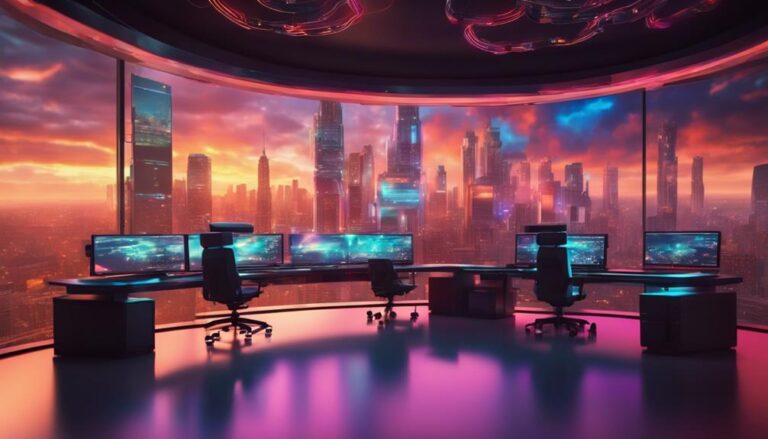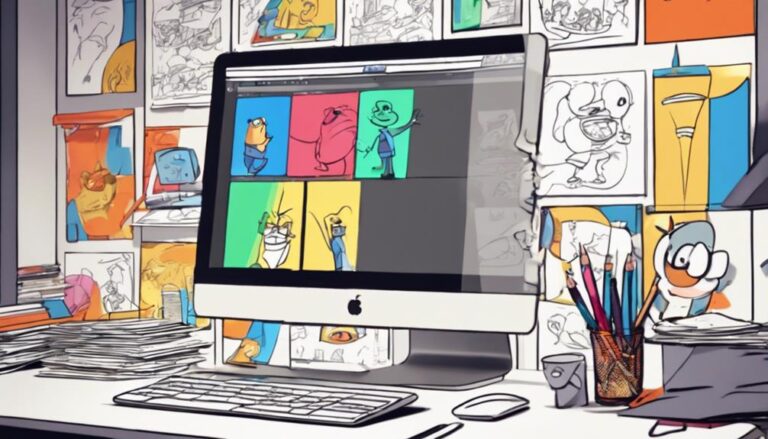5 Best CGI Techniques for Broadcast Animation
As you venture into the world of broadcast animation, you'll quickly realize that creating mesmerizing scenes and characters requires more than just a good story. You need to master the right CGI techniques to bring your vision to life. From creating realistic environments to crafting believable characters, the right tools and methods can make all the difference. But which ones are essential for broadcast animation? You're about to find out. By exploring the most effective CGI techniques, you'll be able to take your animation to the next level and transport your audience to new and exciting worlds.
Key Takeaways
- Ambient Occlusion adds depth and dimensionality to animation by simulating light scattering and blocking by objects in a scene.
- Facial Rigging and Body Mechanics bring characters to life with realistic nuances of human movement and behavior in broadcast animation.
- Physically-Based Rendering solutions accurately capture light interactions with texture and geometry, resulting in detailed and realistic renderings.
- Advanced global illumination techniques, such as Volumetric Lighting, create realistic lighting effects within a 3D environment, enhancing mood and atmosphere.
- Innovative texture and shading tools enable precise control over visual fidelity, allowing for intricate textures and subtle nuances that elevate the overall aesthetic of scenes.
Advanced Global Illumination Techniques
When tackling complex broadcast animation projects, you'll likely need to employ advanced global illumination techniques to achieve photorealistic results, as basic lighting methods often fall short in capturing the subtleties of real-world environments.
Ambient Occlusion (AO) is a technique that simulates the way light scatters and is blocked by objects in a scene. By incorporating AO into your workflow, you can add depth and dimensionality to your animation, making it more believable and immersive.
Another technique to ponder is Volumetric Lighting, which allows you to create realistic lighting effects within a 3D environment. This is particularly useful for scenes that involve fog, mist, or other atmospheric phenomena.
By using Volumetric Lighting, you can create soft, realistic shadows and subtle lighting effects that enhance the overall mood and atmosphere of your animation. To get the most out of these techniques, you'll need to carefully balance their application to avoid over- or under-illuminating your scene.
With practice and patience, however, you can use advanced global illumination techniques to take your broadcast animation projects to the next level.
Realistic Character Animation Methods
As you move on to animating your characters, you'll need to employ realistic character animation methods to bring them to life, integrating the subtle nuances of human movement and behavior into your digital creations.
To achieve this, you'll want to focus on Facial Rigging, which involves setting up a system of bones, joints, and controllers to accurately mimic the complex movements of the human face.
This includes creating a detailed facial topology, defining facial expressions, and tweaking the rig to respond naturally to animation inputs.
In addition to Facial Rigging, you'll need to master Body Mechanics, which involves simulating the way the human body moves and interacts with its environment.
This includes understanding the principles of weight distribution, balance, and movement patterns, as well as setting up a robust skeletal system to drive your character's motion.
Advanced 3D Modeling and Sculpting
You'll need to develop a deep understanding of Advanced 3D Modeling and Sculpting techniques to create highly detailed, realistic characters and environments that captivate your audience.
This requires a strong foundation in polygon modeling, NURBS, and subdivision surface modeling. You'll need to master various tools and software, such as Maya, 3ds Max, or Blender, to create complex organic shapes and structures.
To achieve realism, focus on adding micro details to your models. These can include subtle imperfections, textures, and patterns that give your characters and environments a lifelike quality.
Pay attention to the way light interacts with your models, using techniques like ambient occlusion and normal mapping to enhance the sense of depth and dimensionality.
When sculpting, use a combination of brush-based tools and polygon editing techniques to refine your models. Experiment with different workflows and tools to find what works best for your project.
Physically-Based Rendering Solutions
Employ Physically-Based Rendering (PBR) solutions to simulate real-world lighting and materials, accurately capturing the intricate interactions between light, texture, and geometry in your 3D environments and characters. This approach enables you to create highly realistic scenes by mimicking the way light behaves in the real world. PBR solutions take into account the complex Material Responses to different lighting conditions, resulting in more accurate and detailed renderings.
| Lighting Aspect | PBR Solution |
|---|---|
| Direct Lighting | Simulates direct light rays from sources like the sun or lamps |
| Indirect Lighting | Calculates bounced light and ambient Occlusion |
| Light Transport | Accurately models the way light scatters and absorbs in various materials |
Innovative Texture and Shading Tools
With the advent of innovative texture and shading tools, you can now precisely control the visual fidelity of your 3D assets, creating an unprecedented level of realism in your broadcast animation projects.
These cutting-edge tools empower you to plunge deeper into micro detail enhancement, allowing for intricate textures and subtle nuances that elevate the overall aesthetic of your scenes.
By leveraging material breakdown techniques, you can dissect complex materials into their constituent parts, fine-tuning each element to achieve unparalleled realism. For instance, you can separate a character's skin into individual layers, each with its own unique properties and responses to light.
This granular control enables you to craft rich, immersive environments that transport your audience to new worlds.
Furthermore, advanced shading tools grant you the flexibility to manipulate light interactions, simulating real-world phenomena like subsurface scattering, ambient occlusion, and anisotropic reflections.
Frequently Asked Questions
How Do I Manage Large Project Files and Collaborate With My Team?
You'll efficiently manage large project files by establishing a clear file organization system, setting up project workflows, and utilizing collaborative tools like Git or Asana to streamline communication and task assignments with your team.
What Software Is Best for Beginners in Broadcast Animation Cgi?
When choosing CGI software as a beginner, you'll want to prioritize user experience and ease of use. Popular options like Blender, Maya, and Houdini offer free trials, so test them out to determine which one suits your software preferences and learning style best.
Can I Use CGI Techniques for Live-Action Broadcast Animation?
You can seamlessly merge CGI with live-action footage, creating a live-action fusion that enhances Hybrid storytelling in broadcast animation. By combining the two, you'll achieve a visually stunning, realistic, and engaging viewing experience.
How Do I Ensure Consistency Across Different Animation Styles?
To guarantee consistency across different animation styles, you'll create detailed Style Guides, outlining specific visual elements, and gather Visual References, such as concept art and character designs, to maintain a cohesive look throughout your project.
What Are the Essential Skills for a CGI Artist in Broadcast Animation?
As a CGI artist, you'll need to master texture manipulation, understanding how to create realistic surfaces and subtle variations, as well as lighting fundamentals, including color theory and intensity control to bring your scenes to life.
Conclusion
By mastering these five essential CGI techniques, you'll elevate your broadcast animation to the next level.
Advanced Global Illumination Techniques will transport your audience to richly detailed environments.
Realistic Character Animation Methods will bring your characters to life with nuanced expressions and movements.
Advanced 3D Modeling and Sculpting will craft intricate, lifelike models.
Physically-Based Rendering Solutions and Innovative Texture and Shading Tools will further enhance your visuals.
With these techniques, you'll create immersive, engaging narratives that captivate your audience.







